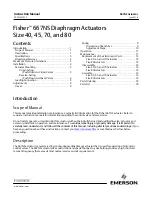
Instruction Manual
D102603X012
667NS Actuator
June 2018
14
Disassembly
Size 40, 45, and 70 Actuators
Key number references are shown in figure 2 for size 40 and 45 actuators and in figure 3 for size 70 actuators.
1. Bypass the control valve. Reduce the actuator loading pressure to atmospheric pressure, and remove the tubing or
piping from the connection in the yoke cap (key 239).
2. To aid in assembly, record the position of the spring adjustor (key 74) on the actuator stem (key 144). Loosen the
spring adjustor jam nut (key 102), and thread the spring adjustor jam nut and the spring adjustor off the actuator
stem until all spring compression is relieved.
3. Remove the entire actuator from the valve body by removing the two cap screws from the stem connector
assembly (key 31), separating the two halves of the stem connector and removing the eight bonnet stud bolt nuts.
4. Thread the spring adjustor jam nut and the spring adjustor off the actuator stem. Remove the spring seat (key 19).
5. Remove the diaphragm casing cap screws and nuts (key 13 and 14), and lift off the upper diaphragm casing (key 1).
6. Take out the diaphragm (key 3), the upper diaphragm plate (key 4), the lower diaphragm plate (key 71), and the
actuator stem as an assembly. Use care when pulling the threads of the actuator stem through the seal bushing (key
7) to avoid damaging the O‐rings (key 8).
7. Remove the diaphragm plate cap screw and spacer (keys 12 and 2) to separate the parts of this assembly.
8. Remove the snap ring (key 72), and lift out the seal bushing (key 7). Remove and check the O‐rings (keys 8 and 9)
for excessive wear or damage.
9. Remove the cap screws (key 30), and take off the lower diaphragm casing (key 64), the gasket (key 70), and the
yoke cap. Lift out the spring (key 18).
Size 80 Actuators
Key number references are shown in figure 4.
1. Remove the cap screws (key 91) and the adjusting screw cover (key 84).
2. Unscrew the hex nuts (keys 85 and 86) from the actuator stem (key 93). Record the position of the spring adjustor
(key 74) relative to the spring case (key 92). Loosen the spring adjustor locknut (key 90), and unscrew the spring
adjustor, relieving all compression from the spring (key 18).
3. Remove the two cap screws from the stem connector assembly (key 31), and separate the stem connector halves.
4. If removal of the actuator is necessary, unbolt the eight bonnet stud bolt nuts, and remove the actuator from the
valve body. Otherwise, leave the actuator mounted on the valve body.
5. Unscrew the cap screws and nuts (keys 13 and 14), and lift the upper diaphragm casing and spring case assembly
(keys 1 and 92) over the spring.
6. Remove the spring seat (key 19), the bearing race and bearing (keys 88 and 89), and the guide bushing (key 97).
7. Lift off the spring.
8. Remove the actuator stem with the attached hex nuts (key 94), the diaphragm plate (key 4), the diaphragm (key 3),
and the lower diaphragm plate (key 71) by carefully sliding the lower end of the actuator stem out of the seal
bushing O‐rings (key 8) and lifting the actuator stem with attached parts clear of the diaphragm case.
9. To aid in unfastening the actuator stem hex nuts (key 94) and to help prevent actuator stem damage, attach the
stem connector assembly onto the actuator stem and grip the stem connector in a vise while unfastening the
actuator stem hex nuts (key 94). Remove the hex nuts (key 94), and inspect the actuator stem and associated parts.
10. Remove the snap ring (key 72), and lift the seal bushing (key 7) and O‐rings (keys 8 and 9) out of the actuator yoke
(key 73).
11. Remove the O‐rings.
























